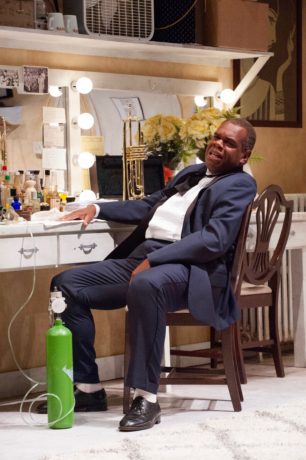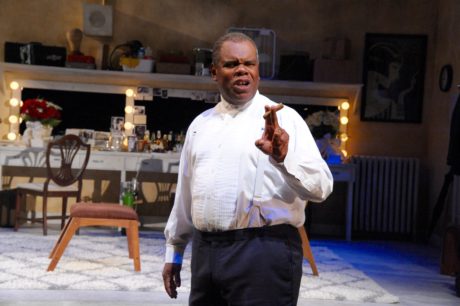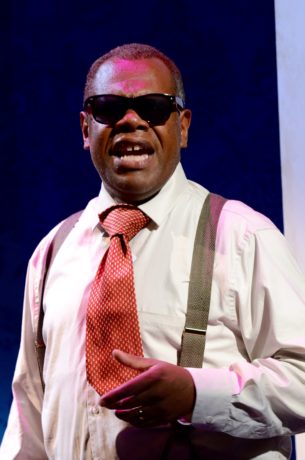It’s poignant and painful, funny and moving. Yet most of all, Satchmo at the Waldorf—the beautifully-wrought one-man show that opened to a packed house Monday night—is vastly entertaining.

As such, Satchmo—which depicts the great Louis Armstrong recording some of his memories in his dressing room at the Waldorf, following what would become his final performance in March 1971—is a terrific choice for the start of the second season at Mosaic Theater Company of DC.
The play, written by Terry Teachout and based on his encyclopaedic biography, explores some of the cruelest betrayals in the history of the music industry.
It’s a tour de force, and—in the hands of Craig Wallace, who delivers a bravura performance as both the title character and the people who essentially robbed him—a master class in acting and music.
Wallace moves seamlessly between the central role of Armstrong and Joe Glaser, his Jewish Mob-connected manager, on the one hand, and Miles Davis, his African-American jazz competitor, on the other. The actor uses a kind of shorthand to indicate which character he is inhabiting. As Glaser, he jabs the air with an unlit cigar. As Davis, he lurks behind dark glasses. .
While very different in their personas, both men boast of coming from educated families, considering themselves superior to Armstrong, who grew up in poverty and was self-taught.
In fact, according to Armstrong lore, the man who became known as Satchmo earned his name in childhood by dancing in the street for pennies, which he then hid behind his wide grin, using his mouth as a “satchel.”
Calling himself “a walking Smithsonian,” Wallace interlaces profanities—drawing huge laughs with his inflection of ‘motherfucker’—with the story of his life, reflecting on its pain and joy.
There is great poignance in his telling about relationships with whites—about Bing Crosby, for example, whom he worked with for 40 years, but who never once invited him home.

The relationship with Glaser, the Jewish manager, is based on servitude. Self-inflicted, perhaps, since Satch naively shrugs off the fact that the guy used to work for Al Capone. But it’s nevertheless a master-servant connection.
Yet there are also ‘Good Jews’ in this saga. In New Orleans, there is the Karnofsky family, Jewish immigrants who more or less adopt him when he is forced to drop out of school at age 10.
The family gives him odd jobs, feeds him at the kitchen table with their own children and–after he has learned to play the trumpet at a genteel reform school (called the Louisiana Colored Waif’s Home for Boys)—buy him his first musical instrument.
Most painful, perhaps, is the rejection on the part of the younger black musicians—personified in this play by the figure of Miles Davis—who accuse him of pandering to white audiences.
He plays a major role in the Civil Right Movement, yet his critics complain that it isn’t enough.
And saddest of all, the new African-American audience prefers be-bop and rock to Satchmo’s beloved jazz.
Yet despite all the disappointments, the prevailing image of Satch is that of a man who loved making music more than he loved making money. And who loved making people happy.
Wallace, who was last seen in Aaron Posner’s imposing adaptation of The Merchant of Venice (District Merchants at the Folger), is a monument to DC’s success on the national theatre scene. He is a veteran of productions at Shakespeare Theatre Company, Olney Theatre Company, Theater J, Woolly Mammoth Theatre Company, Ford’s Theatre, Signature Theatre, and Arena Stage.
While there is no question that the power and credibility of Satchmo stem mainly from Wallace’s performance—which garnered a long standing ovation on opening night—much of the credit must go to its very talented creative and technical team.
Playwright Terry Teachout, based it on his best-selling 2009 biography—Pops—A Life of Louis Armstrong—which tells, in meticulous detail, the story of the man behind the celebrity.
Although this is his first play, Teachout—who is the drama critic at The Wall Street Journal and a critic-at-large at Commentary—also writes librettos.
For Director Eleanor Holdridge, one of the principal goals in bringing the play to life was to create a platform for each of the three characters portrayed by Wallace. Working with Jeanette Buck, Stage Manager, and Set Designer Andrew Cohen, the three have carved out separate spaces for each role, with Miles Davis seen in the shadows at stage right, and Joe Glaser front and center.
Cohen’s set, which replicates a typical dressing room backstage, is a perfect hodge-podge of old furniture, clothing and ‘stuff.’ Timothy Jones has created a wonderful melange of things, including a period hi fi—complete with microphone, tape recorder, and stereo—a fan and an oxygen tank, the latter a sad testament to the fact that Armstrong is in failing health.
Alberto Segarra has designed a panoply of lighting that ebbs from subtle to harsh, and from brightness to shadow, separating the scenes and the characters’ moods.
The sound is ingenious and educational, thanks to Teachout’s script which explains what makes his music original and great—and Christopher Baine’s design, which includes snippets of recordings, played over and over.

Brandee Mathies takes costume design to a new level, as Armstrong slowly sheds the formal tuxedo—revealing the arch supports and underwear of a man who is 70 and in poor health—and puts on a more casual jacket and slacks. The suspenders and white socks are a wonderful touch.
Mosaic’s production of Satchmo at the Waldorf is a DC premiere. The play was first performed in 2011 at the Lowndes Shakespeare Center in Orlando, Florida, and later ran Off-Broadway at the Westside Theatre in 2014.
For Ari Roth, Mosaic’s Founding Artistic Director, Satchmo at the Waldorf is more than a milestone production.
“It’s a towering encounter between three American giants at the center of a cultural revolution,” he says, pointing out that the central conflict is between an African-American and a Jew. “It’s the relationship with Joe Glaser, the combative manager behind Armstrong’s meteoric rise in white culture, that exposes a complex, troubled and deeply unresolved history.”
Running Time: 80 minutes, with no intermission.
Satchmo at the Waldorf plays through September 25, 2016, at Mosaic Theater Company of DC performing in the Lang Theatre at Atlas Performing Arts Center – 1333 H Street NE, in Washington, DC. For tickets, call the box office at (202) 399-7993 ext. 2, or purchase them online.
RATING:





